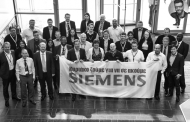Αγαπητέ μου Διονύση εύχομαι πάντα νάχεις καλή υγεία κέφι και όρεξη .Εγώ πάντα σε παρακολουθώ και σε θαυμάζω καλή σου συνέχεια.
Γυρω στο 1960 είχαμε στο Γυμνάσιο Ιθάκης έναν Λευκαδίτη γυμναστή Δημήτριο(Τάκης) Ροντογιάννης δεν ξέρω αν τον θυμάσαι ήταν σε όλους πολύ αγαπητός. Αν ανοίξεις τα links θα Διαβάσεις για τον βραβευμένο αρχιτέκτονα Κώστα Τσιαμπάο είναι έγγονος του καθηγητή από την κόρη του Θεωδόρα Ροντογιάννη καθηγήτρια στο πολυτεχνείο. Αν σε ενδιαφέρει έχεις χώρο και όποτε μπορείς γράψε 2 λεξούλες αν θέλεις
Και αν πρέπει εγώ απλός στο στέλνω για ενημέρωση.
Σου επισυνάπτω επίσης και μια φωτογραφία για να θυμηθείς εσύ η κάποιος άλλος τον καθηγητή ΡΟΝΤΟΓΙΑΝΝΗ.
Σε όλους τα χαιρετίσματα και την αγάπη μου ΚΩΣΤΑΣ ΠΑΤΡΙΚΙΟΣ
——————————————————————————————————————————-
Μια σημαντική διάκριση για ένα Λευκαδίτη, τον αρχιτέκτονα, Κώστα Τσιαμπάο, γιό της Θοδώρας Ροντογιάννη, καθηγήτρια στο ΕΜΠ. Απέσπασε το βραβείο ουτοπικής πρότασης για την Αθήνα. Πρόκειται για μια σημαντική διάκριση που πήρε στον πανευρωπαϊκό διαγωνισμό Re-Think Athens για τον ανασχεδιασμό του κέντρου της Αθήνας. Πρόκειται για πανευρωπαϊκό διαγωνισμό ο οποίος οργανώθηκε από το Εθνικό Μετσόβιο Πολυτεχνείο, τον Δήμο Αθηναίων και το Ίδρυμα Ωνάση. Στόχος του διαγωνισμού ήταν ο ανασχεδιασμός της οδού Πανεπιστημίου, της πλατείας Κοραή, της πλατείας Δικαιοσύνης, της πλατείας Ομονοίας και της οδού Πατησίων μέχρι το Αρχαιολογικό Μουσείο.
Στην επιτροπή αξιολόγησης του διαγωνισμού συμμετείχαν ο Δήμαρχος Αθηναίων Γιώργος Καμίνης, γνωστοί αρχιτέκτονες από την σχολή αρχιτεκτόνων του Εθνικού Μετσοβίου Πολυτεχνείου αλλά και σημαντικοί αρχιτέκτονες και πολεοδόμοι από καταξιωμένα πανεπιστήμια του εξωτερικού όπως το Harvard, το Columbia, το ΜΙΤ και το Cooper Union. Στον διαγωνισμό κατατέθηκαν 71 προτάσεις πολλές από τις οποίες ανήκαν σε Ευρωπαίους αρχιτέκτονες. Η ανακοίνωση των αποτελεσμάτων έγινε την Τετάρτη 27 Φεβρουαρίου στο Ίδρυμα Ωνάση. Το πρώτο βραβείο απέσπασε μεγάλο και σημαντικό Ολλανδικό γραφείο που ειδικεύεται στον αστικό σχεδιασμό.
“Act as if your maxims should serve at the same time as the universal law”
Immanuel Kant, Foundations of the Metaphysics of Morals
The public space in Greece is usually neglected by the authorities and treated with indifference and hostility by the Greek citizens. As a consequence even highly sophisticated urban design often fails to produce a public space which is functional in the long term. Omonia square is a vivid example of this case.
In order to redefine the relation between urban design and the particularities of the Greek case we propose an approach that is based in the architectural discipline and at the same time uses tools and methodologies borrowed from sociology and social anthropology. This interdisciplinary approach aims at providing a framework which insures that Panepistimiou Street becomes a place that engages with the citizens of Athens and at the same time redefines their relationship with the public realm.
In order to understand this relationship we have to examine the Greek mentalities that define the relation between the collective and the individual. Socially-dispersed small land holdings in Greece has led to widespread private property and housing, in contrast with the mass housing projects typically encountered in the rest of Europe. Small land holdings historically determined a specific relation between the individual and the state that reinforces individuality while at the same time society and the state are treated by the individual as hostile entities.
Panepistimiou street can become a case study for the creative redefinition of this social and historical convention. We divide the length of the central area of Panepistimiou Street into small pieces of land. We ask the citizens of Athens to adopt these pieces of urban space for a four years period, through a lottery selection process which incorporates certain criteria. There will be a series of analytical regulations in the form of a Panepistimiou Street Charter which will insure that the citizens will have very well defined rights and obligations towards their public place.
In front of the Library, the University, and the Academy pieces of land will be offered for adoption to Greek citizens who are recognized by their significant contribution to the arts and the sciences and will be selected every four years by the president board of the Academy of Athens and the senate of the National University of Athens.
Panepistimiou street offers the opportunity to establish a creative and educational process that will help Greek citizens to reconceptualize their relationship with the social realm. Panepistimiou Street will offer the opportunity to establish an educational process. Participating in the interpretation, transformation and maintenance of the public space will help the citizens of Athens to understand that by co-defining and respecting a common set of rules and regulations they do not restrict their creativity or individual freedom but on the contrary they insure and even reinforce them both.
The catalyst towards a new city center will be its active and responsible citizens and not its superficially redesigned image.
THE PANEPISTIMIOU STREET CHARTER
1. The rights and obligations of the adoptive citizens will be analytically determined through a series of regulations that takes the form of a Charter. The Panepistimiou Street Charter pays homage at the Athens Charter by Le Corbusier. The aim of the Charter is to define the citizens’ rights and obligations towards the public space not as imposed restrictions but as well designed common agreements. The Panepistimiou street Charter will insure that the adoptive citizens will be able to express their own individuality respecting the individuality of the others and insure a collectivity which is functional and stimulating at the same time.
2. The small land holdings will be adopted for a period of four (4) years by a citizen of Athens or by a non-profit organization through lottery. The lottery process will incorporate certain criteria. Every citizen or non profit organization willing to adopt a small land holding in Panepistimiou Street has to submit a statement of purpose describing why they are interested in participating in the Panepistimiou Street Project. These statements will be evaluated by a committee.
3. The committee who will be responsible for evaluating the statements of purpose will be constituted by five members. One member of the committee will be commissioned by the Ministry of the Environment, Energy and Climate Change, one will be assigned by the Municipality of Athens, one by the School of Architecture of the National Technical University of Athens, one by the School of Law, Economics and Political Sciences of the National and Kapodistrian University of Athens and one by the Academy of Athens.
4. The pavement of the adopted spaces will be made out of concrete. The adoptive citizens of non profit organizations will have their name engraved in the pavement of the adopted public place for the four year period of the adoption. The adoptive citizens or non profit organizations will also have the right to engrave into the pavement a personal quote.
5. Every adopted urban place will have a seat in the form of a household couch made out of concrete.
6. In both sides of the streets we keep a lane of four (4) meters width as a typical pedestrian walk.
7. The cafeterias and restaurants across the street will be able to use part of this pedestrian walk as is the usually case in the Greek cities.
8. Each citizen or non-profit organization will have the right to organize non commercial events that take place in the adopted public place three times a year after informing the Municipality of Athens for the dates of the events.
9. The citizens will also have the right to install certain additional constructions in predetermined places in their pubic space such as urban furniture, small shelters or pieces of art for the four years period of their space adoption. All the additional constructions will be paid by the citizens and will de designed and produced in collaboration with a workshop staffed with architects, industrial designers and technicians appointed by the Municipality of Athens and the School of Architecture in the National Technical University of Athens.
10. An adoptive citizen or non-profit organization does not have the right to forbid the free pedestrian circulation throughout the adopted land holding, except the days of the events that take place in the adopted public space.
11. An adoptive citizen or non-profit organization does not have the right to forbid the public use of the concrete seat in the adopted land holding, except the days of the events that take place in the adopted public space.
12. Every adoptive citizen or non-profit organization has the right to be present and active in the adopted public space without any restriction or control apart from the generally defined legality.
13. Panepistimiou street and Patision Street have now two arrows of trees. All the healthy trees will remain in place and more trees of the same species will be planted in order to supplement the same arrows. Every adopted urban place will have a tree. Each citizen will be responsible for the tree in his or her public place.
14. The adoptive citizens or non-profit organizations will hold a high supervision on their land holding insuring the maintenance and the general quality of their public space.
Cultural background and future prospects
We believe that Panepistimiou street will work as an educational process for the Greek citizens, a process that will help them redefine their relationship with the public space. The engravement of the adoptive citizens’ name will expose the individuals in the eyes of the community enforcing the sense of the responsibility of the individual towards the collective.
In traditional Greek agricultural society, individuals would take care of the public space such as the village square or a village’s street. Members of the community would have the chance to offer an urban infrastructure in the form of a donation to the community. Fountains, public faucets, sculptures, pavements, trees were some of the urban infrastructure offered by specific individuals in the form of donations to the community. Part of this process that reinforced the relation between the individual and the collective was the engravement of his or her name, so that the community remembers the donation and honors the donator. The Panepistimiou project reinterprets this tradition in a contemporary way.
Greek society is a hybrid between tradition and hyper-modernity. We can assume that behaviors towards the public space are shaped through this particular social and historical convention. We believe that this can lead to the transformation of the Greek attitude towards the city and the elaboration of a strong civic culture for the citizens of Athens.
Omonia Square
Omonia square is the most important traffic hub of Athens. The electric railway and metro station occupy the whole underground area. Thousands of people travel everyday through the city using Omonia square as a crossing point. Until now the dynamism of this crossing point is completely hidden while thousands of people spend some time everyday underground walking or waiting for their train in low ceiling spaces. Hiding the real function of Omonia and trying nostalgically to create a traditional square in the form of a 19th century urban plaza will always fail to face the case of Omonia. We propose to uncover the whole area and transform the underground railway and metro station to an open space. This way we provide the citizens of Athens with an open air metro station in the heart of the city. Omonia square will be successful when we respect its true power, the thousands of citizens who travel everyday throughout the city highlighting this contemporary urban factor.
We propose the same in the case of Korai street uncovering the entrance to the metro station across the building of Panepistimio.
Ευρωπαϊκός Αρχιτεκτονικός Διαγωνισμός για την ανασυγκρότηση του κέντρου της Αθήνας «Rethink Athens, ξανα-σκέψου την Αθήνα» / Τιμητικό Βραβείο Ουτοπικής πρότασης / Αρχιτέκτονες: Κώστας Τσιαμπάος-Μυρτώ Κιούρτη / Σύμβουλος: Παναγής Παναγιωτόπουλος (Τμήμα Πολιτικής Επιστήμης και Δημόσιας Διοίκησης ΕΚΠΑ).





















